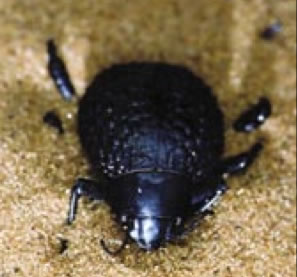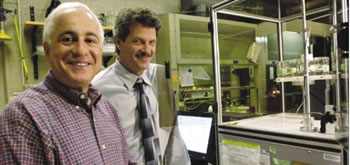Science Fiction
Dictionary
A B C D E F G H I J K L M N O P Q R S T U V W X Y Z
Namib Desert Beetle-based Dune Dew Collectors

The Namib Desert beetle lives in one of the driest places on earth - just one half of an inch of rain per year. When early morning fog offers the hint of moisture, the beetle is ready to take a drink - from the amazing surface on its back. MIT researchers, inspired by the beetle, have created a material that can capture and control tiny amounts of water.

(The Namib Desert beetle - photo by Andrew Parker)
When the slightest fog blows horizontally across the beetle's back, water droplets just 15-20 microns in diameter start to accumulate on the bumps on its back. The bumps are surrounded by waxy water-repelling channels. When a bump collects enough water to form a big droplet, it rolls down a channel right into the beetle's mouth.
MIT researchers Robert Cohen and Michael Rubner were inspired by a 2001 article in the journal Nature describing the beetle, and thought it would be a good candidate for biomimicry - the imitation of a natural-world solution to a problem.

(MIT researchers Cohen and Rubner in situ in their lab)
Their newly designed material combines a superhydrophilic (water-attracting) surface with superhydrophobic (water-repelling) surface. A Teflon-like substance is applied to a surface (for water-repulsion); silica nanoparticles and charged polymers help create a rough texture to attract droplets. The research was funded by our good friends at DARPA.
Science fiction writer Frank Herbert wrote about this same idea in his remarkable 1965 novel Dune. Most of the novel takes place on the planet Dune, which has no liquid surface water at all. In order to plant vegetation, special materials are used to create dew collectors, to gather even the tiniest amount of moisture.
"Each bush, each weed you see out there in the erg," she said, "how do you suppose it lives when we leave it? Each is planted most tenderly in its own little pit. The pits are filled with smooth ovals of chromoplastic. Light turns them white. You can see them glistening in the dawn if you look down from a high place. White reflects. But when Old Father Sun departs, the chromoplastic reverts to transparency in the dark. It cools with extreme rapidity. The surface condenses moisture out of the air. That moisture trickles down to keep our plants alive."
(Read more about Frank Herbert's dew collectors)
In the dew collectors of Herbert's imagination, a special material changes from light to dark in order to pull moisture out of the air. Cohen and Rubner's new material should be able to do the same trick using a different technology.
If you are interested in these materials science stories, take a look at Water-Repellent 'Bumpy' Glass Mimics Lotus Leaves and Arachnid Adhesion: The Sticky Feet Of Spiders.Read more at Beetle spawns new material.
Scroll down for more stories in the same category. (Story submitted 6/18/2006)
Follow this kind of news @Technovelgy.| Email | RSS | Blog It | Stumble | del.icio.us | Digg | Reddit |
Would
you like to contribute a story tip?
It's easy:
Get the URL of the story, and the related sf author, and add
it here.
Comment/Join discussion ( 3 )
Related News Stories - (" Material ")
Harvard Metamaterials Change Structure Instantly
'Annealed in any shape for a time, and codified, the structure of that shape is retained down to the molecules.' - Samuel R. Delany
Nano-Chainmail 2D Mechanically Interlocked Polymer
'Nemourlon armor of reasonable weight resists penetration by most fragments and any bullet that is not both reasonably heavy and fairly high-velocity.' - Jerry Pournelle, 1976.
Goldene - A Two-Dimensional Sheet Of Gold One Atom Thick
'Hasan always pitched a Gauzy - a one-molecule-layer tent, opaque, feather-light, and very tough.' - Roger Zelazny, 1966.
FlexRAM Liquid Metal RAM And One Particular SF Movie Robot
'Its lines wavered, flowed, and then painfully reformed.' - Philip K. Dick, 1957.
Technovelgy (that's tech-novel-gee!) is devoted to the creative science inventions and ideas of sf authors. Look for the Invention Category that interests you, the Glossary, the Invention Timeline, or see what's New.
Science Fiction
Timeline
1600-1899
1900-1939
1940's 1950's
1960's 1970's
1980's 1990's
2000's 2010's
Current News
Replace The Smartphone With A Connected Edge Node For AI Inference
'Buy a Little Dingbat... electropen, wrist watch, pocketphone, pocket radio, billfold ... all in one.'
Artificial Skin For Robots Is Coming Right Along
'... an elastic, tinted material that had all the feel and appearance of human flesh and epidermis.'
Robot Guard Dog On Duty
I might also be thinking of K-9 from Doctor Who.
Wearable Artificial Fabric Muscles
'It is remarkable that the long leverages of their machines are in most cases actuated by a sort of sham musculature...'
BrainBridge Concept Transplant Of Human Head Proposed
'Briquet’s head seemed to think that to find and attach a new body to her head was as easy as to fit and sew a new dress.'
Google's Nano Banana Pro Presents Handwritten Math Solutions
'...copy was turned out in a charming and entirely feminine handwriting.'
Edible Meat-Like Fungus Like Barbara Hambly's Slunch?
'It was almost unheard of for slunch to spread that fast...'
Sunday Robotics 'Memo' Bot Has Unique Training Glove
'He then started hand movements of definite pattern...'
Woman Marries Computer, Vonnegut's Dream Comes True
'Men are made of protoplasm... Lasts forever.'
Natural Gait With Prosthetic Connected To Nervous System
'The leg was to function, in a way, as a servo-mechanism operated by Larry’s brain...'
Spidery 'Walk Me' Toyota Autonomous Wheel Chair Like Star Wars
Walk along with the emperor.
Dancing Robots Taught Dance Moves
'A clockwork figure would be the thing for you...'
Proof Of Robothood - Not A Person
'Who are you people? - Show 'em.'
Indonesian Clans Battle
'The observation vehicle was of that peculiar variety used in conveying a large number of people across rough terrain.'
The 'Last Mile' In China Crowded With Delivery Robots
Yes, it's a delivery robot. On wheels.
Tornyol Microdrone Kills Mosquitoes
'The real border was defended by... a swarm of quasi-independent aerostats.'
